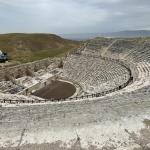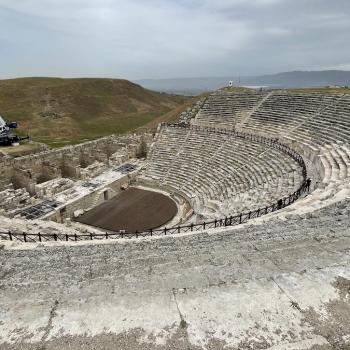
When we do theology in community, we mitigate these biases. Yet a community bias might emerge out of local cultural contexts, necessitating a larger hermeneutical community that includes brothers and sisters from different cultures participating in the process of missiological theology. It sounds like a daunting undertaking, and it is. However, taking the time to ensure proper translation, interpretation, and application is a step to developing mature disciples who will be able to effectively take God’s story and connect it to the stories of the people. Church polity is one of those areas where a bias appears to have crept into the interpretation of leadership roles early in the church’s formation, and the bias continues into the twenty-first century.
One area where a bias clearly appears is in the contemporary church’s understanding of the position of a deacon. In the English Standard Version (ESV) of the New Testament, the Greek word διάκονος (diakonos) is translated in four ways—“servant,” “attendant,” “minister,” or “deacon.” In total, the word is used twenty-eight times, and the translators only chose to render it literally as “deacon(s)” three times—and only in Paul’s epistles (Phil 1:1; 1 Tim 3:8, 12). In the ESV, it is most commonly translated “servant” (eighteen times) or “minister” (seven times). Seven of the eighteen references to diakonos as “servant” are found outside of the Pauline corpus and exclusively in three Gospels (Matt 20:26;23:11; Mark 9:35; 10:43; John 2:5, 9; 12:26).
Paul’s Use of Diakonos
Paul uses the word twenty-one times, and the ESV translates it as “servant,” “minister,” or “deacon.” Two of those references are directed as a description of Jesus (Rom 15:8; Gal 2:17), and two references are to Satan’s emissaries (2 Cor 11:15). Twelve times the word diakonos refers to Paul or one of his associates. In seven of those cases, the word refers to a male associate or to himself and is translated “minister:” Epaphras (Col 1:7), Paul (Eph 3:7; Col 1:23, 25), Tychicus (Eph 6:21; Col 4:7), and Paul and Timothy (2 Cor 3:6). In five cases, it is translated “servant” and refers to both male and female associates as well as to himself: Phoebe (Rom 16:1), Apollos and Paul (1 Cor 3:5), Paul and Timothy (2 Cor 6:4), Paul (2 Cor 11:23), and Timothy (1 Tim 4:6).
While an argument can be made for the lexical range in Paul’s use of diakonos to include all three iterations (servant, minister, deacon), such an argument is not necessary. In fact, since Paul uses δοῦλος (doulos; “bond servant”) twenty-eight times, one must ask why he would use two different words to communicate a similar idea, especially since he uses diakonos in such a precise way as a “function” in the church (Phil 1:1; 1 Tim 3:8, 12).
Word Preference
The question that emerges from the translation of the word diakonos in the Pauline corpus is why to prefer “minister” or “servant” over “deacon.” In reference to Christ and Satan’s emissaries, an argument can be made for translating the word “servant.” In the remaining verses, however, there doesn’t seem to be a clear context in which a preference for “minister” or “servant” is warranted over “deacon.” Does this mean that we throw out eighteen centuries of church leadership structures in which the office of deacon meant carrying out “menial tasks and duties,” as Thabiti Anyabwile noted (2012, 25)? Are these “menial tasks and duties” sacred responsibilities that we see demonstrated in Scripture? The responses to these two questions will help determine the church’s identity as an institution or a movement.
Leaders of Movements
As I look at the type of New Testament leadership that grows a movement, I am inclined to translate the word diakonos consistently whenever it is used in relationship to people. In doing so, the group of leaders at the heart of the movement—Paul, Timothy, Apollos, Tychicus, Epaphras, and Phoebe—were all diakonoi, who served the church in the following ways: as apostles (Acts 19:22; Eph 3:7), as prophets (2 Cor 3:6, 12–18), as evangelists (1 Cor 3:5–6; 2 Tim 4:5), or as shepherd-teachers (Eph 6:21–22; Col 4:7–8; 1 Tim 4:6).
Such an interpretive translation puts Ephesians 4:11–12 in context: “And he gave some as the apostles, as the prophets, as the evangelists, as the shepherds who are teachers (τοὺς δὲ ποιμένας καὶ διδασκάλους, tous de poimenas kai didaskalous), to equip the saints for the work of ministry (εἰς ἔργον διακονίας, eis ergon diakonias), for building up the body of Christ” (my translation).
Using this plain reading of the texts, Paul saw leadership as a community function rather than as a hierarchy. The goal of leadership was to equip believers for ministry (διακονία; diakonia). Paul uses the Greek diakonia (ministry) as much for what others were to do as for what he also did. He spoke about the diakonia of reconciliation in 2 Corinthians 5:18 and his diakonia to the Gentiles in Romans 11:13. The diakonia was not to make anyone stumble (2 Cor 6:3). Both Archippus (Col 4:17) and Timothy (2 Tim 4:5) were to fulfill their diakonia, and Mark was useful to Paul for diakonia (2 Tim 4:11).
Everyone Involved in Diakonia
What we sometimes fail to see in Paul is his desire to include everyone in diakonia. Each disciple was to be a part of diakonia, just as he was. Paul seems to love to place himself alongside of others in diakonia. We have already seen him include himself with Timothy, Apollos, Epaphras, Tychicus, and Phoebe. We have seen him coauthor seven of his thirteen epistles with Silvanus (1 Thess 1:1; 2 Thess 1:1), Timothy (2 Cor 1:1; Phil 1:1; Col 1:1; 1 Thess 1:1; 2 Thess 1:1; Phlm 1), and Sosthenes (1 Cor 1:1). Perhaps nowhere is Paul’s shared leadership highlighted better than in Romans 16:3–16:
Greet Prisca and Aquila, my fellow workers in Christ Jesus, who risked their necks for my life, to whom not only I give thanks but all the churches of the Gentiles give thanks as well. Greet also the church in their house. Greet my beloved Epaenetus, who was the first convert to Christ in Asia. Greet Mary, who has worked hard for you. Greet Andronicus and Junia, my kinsmen and my fellow prisoners. They are well known to the apostles, and they were in Christ before me. Greet Ampliatus, my beloved in the Lord. Greet Urbanus, our fellow worker in Christ, and my beloved Stachys. Greet Apelles, who is approved in Christ. Greet those who belong to the family of Aristobulus. Greet my kinsman Herodion. Greet those in the Lord who belong to the family of Narcissus. Greet those workers in the Lord, Tryphaena and Tryphosa. Greet the beloved Persis, who has worked hard in the Lord. Greet Rufus, chosen in the Lord; also his mother, who has been a mother to me as well. Greet Asyncritus, Phlegon, Hermes, Patrobas, Hermas, and the brothers who are with them. Greet Philologus, Julia, Nereus and his sister, and Olympas, and all the saints who are with them. Greet one another with a holy kiss. All the churches of Christ greet you.
What a remarkable example of community leadership. Just consider the terms: “fellow workers,” “my kinsmen,” “my fellow prisoners,” “my beloved”—terms of affection from one movement leader to other movement leaders. Paul’s leadership focused on equipping more leaders, and he believed that all disciples—those who had been adopted into the family of God (Eph 1:5)—were also responsible for diakonia just as he was responsible for diakonia. This in no way diminishes Paul’s leadership. On the contrary, Paul’s leadership is set apart as that which motivated others to continue on God’s mission of seeing more people worship him. It is a leadership that distinguishes a movement from an institution.
*excerpt from Ephesiology: A Study of the Ephesian Movement
Celebrate Ephesiology’s “First” Anniversary
Published on the auspicious date of 29 February 2020, Ephesiology: A Study of the Ephesian Movement celebrates its first anniversary on this 2024 leap day. Pick up your copy at Amazon.
I am convinced that Jesus has designed his church for world transformation—that world impact is baked into the very nature and design of the church. Michael Cooper knows this and has focused his scholarship on trying to figure out the inherently movemental nature of the church. Ephesiology is precisely the kind of reflection on the missional potential of the New Testament church that is needed in our time. It deserves to be widely read.
Alan Hirsch
Award winning writer on movemental theology, spirituality, and leadership including books like The Forgotten Ways and The Permanent Revolution.
Founder of Forge Missional Training Network, 100 Movements, and The 5Q Collective.

Pick up the book at Amazon












